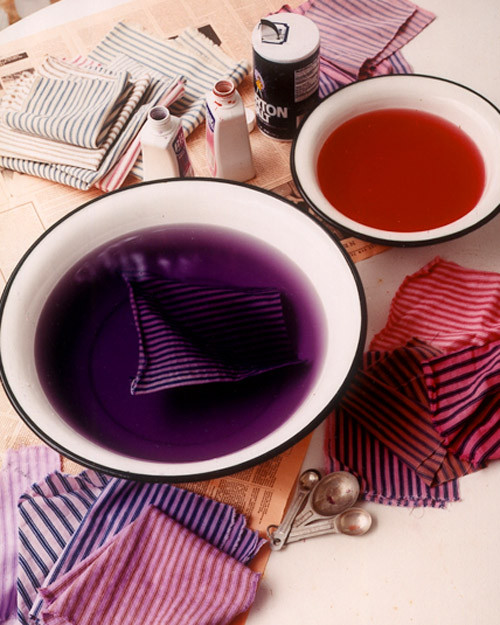

Rebecca Fretty is chief creative inspiration officer and the founder of the Rit Studio. Dianne Giancola, who started her career as a home economics teacher, has been the Rit education director for more than a decade.
Any overall secrets for success?
Here are three important ones:
First, use hot water. Rit dye really needs hot water to create deep, saturated colors. The hotter the better! We often boil water and then pour that directly into the dye bath.
Second, don’t forget to stir. Often folks have spotting or streaking on projects because their material gets folded in the dye bath and the pigment cannot reach all the material evenly. Keep the fabric moving in the dye bath.
Third, add more dye for dark colors. When dyeing dark colors, we recommend doubling the amount of dye in the dye bath. It’s most important with black. We always use a whole bottle of black for one pair of pants. This—and hot water—give a rich dark black every time.
What trends are you seeing in dyeing?
Ombré (shading from dark to light) and shibori (a Japanese type of dyeing that results in a really interesting pattern) are popular right now. Both of these are simple and give projects such a professional quality. People write to us all the time so excited that their friends cannot believe they did this at home!
What should you do if you dye something and don’t like the color or result? Is there any going back?
Yes! Rit Color Remover lets you remove dye from a project you didn’t love. You can also use it to reduce the amount of color in a material before you dye it.
We like dyeing items made from materials other than fabric. Any ideas?
We love dyeing unusual things too! Wood is one of our favorite materials, because you can see the wood grain through the dye. With our all-purpose Rit dye we have had tremendous success dyeing corks, dried flowers, corn husks, pinecones, feathers, and sand.
Our new Rit Dye More also lets you dye synthetics such as polyester, acrylic, and nylon. It even works on plastic. We think it is fun to make all sorts of colored Lego bricks!
Most unusual items are best dyed in a bucket with hot water. Or you can make a jar of diluted dye for painting on an item like canvas or paper.
Should I dye items in my washing machine, sink, or bucket/bin?
It really is up to you. The washing machine is the easiest, and really the only way to dye large items like towels or curtains. Just throw your item in the washing machine, pour the dye in the detergent dispenser, and let the washing machine do all the work. However, you don’t have any control over the process.
If you want to make an ombré pattern or or check on the exact level of color, then you should use a bucket or sink, or the stovetop method.
And when you are dyeing synthetic fibers, you must use the stovetop method, because the water needs to be sustained at 180 degrees the whole time. Polyester needs to stay in the dye bath for 30 minutes to achieve the most saturated color.
Get all our tips and tricks for mixing colors and dyeing fabric here.
SOURCE:http://www.marthastewart.com/1112024/create-color-five-questions-experts-rit-dye